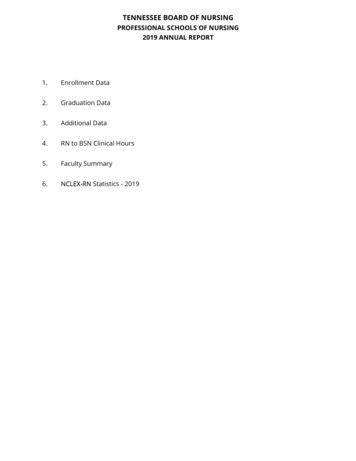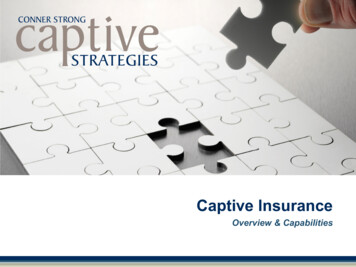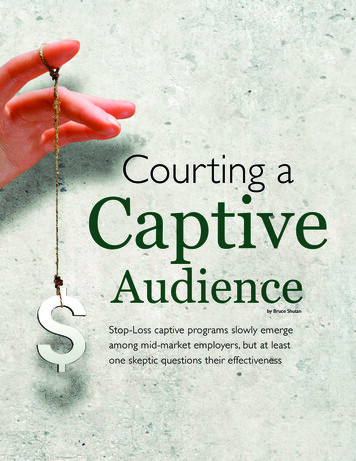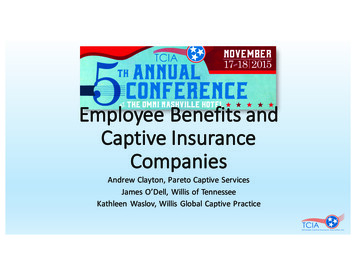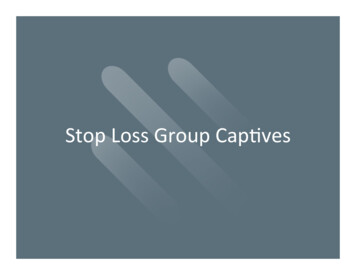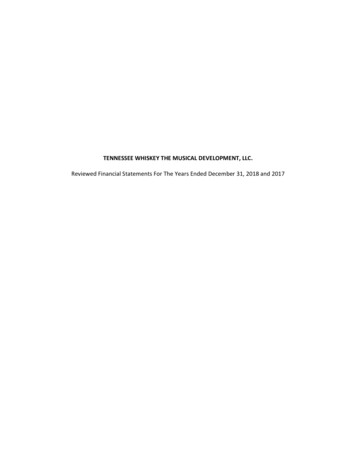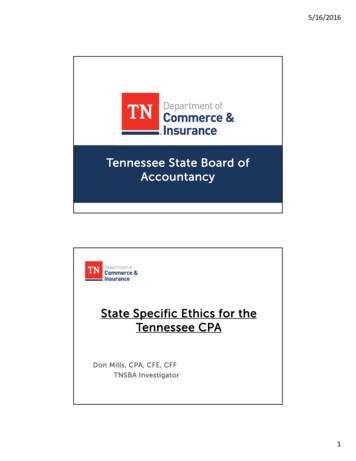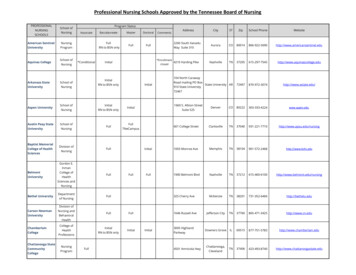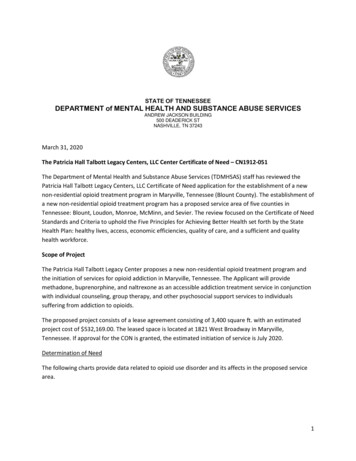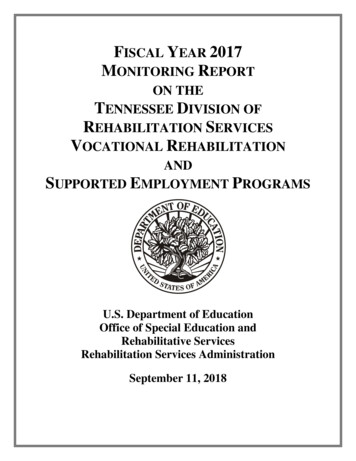
Transcription
TENNESSEECAPTIVE 2015LEGISLATIONCreating a captive-friendly domicileSYNERGYMoving in the same directionGROWTHNow the home of 302 risk-bearing entitiesFrom the publishers of
INTRODUCTIONWELCOME!As the commissioner of the Tennessee Department of Commerce and Insurance, I ampleased to highlight the successes earned by the TennesseeCaptive Insurance Section in recent yearsand discuss our future.Backed with the full support of Governor Bill Haslam and the Legislature, Tennessee’s captive statute was revised in 2011to create effective, flexible and balancedregulations that are focused on a businessmindset and marketplace needs.Along with our new, modernized laws,Tennessee installed a trained regulatorystaff whose goal is establishing Tennessee asa viable captive domicile to promote investment and job creation. Leading that team isMichael Corbett, a regulator with 30 yearsof financial experience in the private sectorwho has helped build and develop our topflight staff and work with businesses choosing Tennessee as a domicile.Our work is paying dividends as Tennessee takes its place on the internationalstage as a destination for captive insurancecompanies.Since 2011, Tennessee has become hometo 302 risk-bearing entities (83 captive insurance companies and 219 cell companies). In financial year 15-16, revenues forcaptive insurance will grow in Tennessee toapproximately 2.3m from 1.3m in financial year 14-15. Projections show Tennesseecollecting 4m in financial year 16-17. Andthe accolades are piling up too, as MichaelCorbett was named 2015 Captive Professional of the Year during the US CaptiveServices Awards.Looking ahead, we must continue to im-3prove Tennessee’s captive insurance statute, ensuring that it stays relevant to thechanging needs of the business marketplace. We must maintain a regulatory staffthat has a sterling reputation as knowledgeable, experienced and supportive. Wemust support the service provider industryas it continues to expand across Tennessee.When you think of a captive domicile,think of Tennessee. You are welcome here!Julie Mix McPeakCommissioner, Tennessee Departmentof Commerce and InsuranceCommissioner Julie Mix McPeak is the first womanto serve as chief insurance regulator in more thanone state. She brings to the department more than14 years of legal and administrative experience instate government.TENNESSEE REPORT 2015 WWW.CAPTIVEREVIEW.COM
TENNESSEE CONTENTS6 THE IRS’ 2015 “DIRTY DOZEN” LIST OFTAX SCAMS27 BUILDING A CAPTIVE DOMICILEKevin Doherty, partner of Nelson Mullins and chair ofTCIA, talks to Captive Review about Tennessee’s strategyfor captive growth and considers the future of theindustry in the domicile.Matthew J. Howard of Moore Ingram Johnson & Steele,LLP, comments on the IRS “Dirty Dozen” list of tax scamsfor the 2015 filing season8 CLEARING UP THE CONFUSION28 KEEPING CAPTIVES COMPLIANTSean King and Nate Reznicek, of CIC Services andAssurance Partners LLC. respectively, help shed somelight on the growth of micro captives and confusionsurrounding themMichael A. DiMayo and Kevin E. Myers, principals atOxford Risk Management Group, discuss the importanceof ensuring compliance and other things to consider forenterprise risk captives making an 831(b) election11 THE ROLE OF THE ACTUARY IN THE LIFEOF A CAPTIVE31 EVALUATING RISKScott Schumpert, a partner at Carr, Riggs & Ingram,explains how the captive insurance model can helpmiddle-market businesses expand their risk managementprofileThomas E. Meyer and Daniel A. Linton of Select ActuarialServices discuss how the actuary fits into the life of thecaptive12 SUPPORTING CAPTIVES33 REDUCING THE COST OF HEALTHCAREDeryl J. Bauman and Bryan Bell of First Tennessee Bankdiscuss the bank’s role in the Tennessee captive marketAndrew Cavenagh, managing director and founder ofPareto Captive Services, talks to Captive Review aboutwhat an employee benefit captive can offer medium-sizedemployers15 THE CAPTIVE MANAGER AND THEMIDDLE MARKET36 TENNESSEE: A LEADER IN CAPTIVEINSURANCEJoel Pina of KRP Managers talks to Captive Review aboutthe role of the captive manager for middle marketbusinessesNorman Chandler, co-founder of Arsenal InsuranceManagement, explains why Tennessee is a leadingdomicile for captive insurance companies19 REACTING TO CHANGES IN TAXATIONBill Buechler of Crowe Horwath discusses changes to theTennessee Industrial Insured Tax and how the industrymight react39 THINK TENNESSEESummary by Michael A. Corbett of Tennessee’sDepartment of Commerce & Insurance24 CAPTIVES FOR ANY SIZE EMPLOYER41 SERVICE DIRECTORYWilliam C. Beeler, president of Risk Solutions Captive,Inc., talks to Captive Review about how healthcarecaptives can fit the needs of employers of all sizesREPORT EDITOR Mike Sheen 44 (0)20 7832 6628 m.sheen@pageantmedia.com // CAPTIVE REVIEW EDITOR Richard Cutcher 44 (0)20 7832 6659 r.cutcher@captivereview.com // GROUP HEAD OF CONTENT Gwyn Roberts // HEAD OF PRODUCTION Claudia Honerjager // DESIGNER Jack Dougherty // SUB-EDITORSLuke Tuchscherer, Mary Cooch, Alice Burton // PUBLISHING DIRECTOR Nick Morgan 44 (0)20 7832 6635 n.morgan@captivereview.com // PUBLISHING ACCOUNTMANAGERS Jessica Ramella 44 (0)20 7832 6631 j.ramella@captivereview.com // Lucy Kingston 44 (0)20 7832 6637 l.kingston@captivereview.com // DATA/CONTENT SALES Nick Byrne 44 (0)20 7832 6589 n.byrne@captivereview.com // Alex Blackman 44 (0)20 7832 6595 a.blackman@pageantmedia.com // HEAD OFEVENTS Beth Hall 44 (0)20 7832 6576 b.hall@captivereview.com // EVENTS MANAGER Jessica Jones 44 (0)20 7832 6517 j.jones@captivereview.com //CEO Charlie KerrPublished by Pageant Media,Thavies Inn House, 3-4 Holborn Circus, London, EC1N 2HAISSN: 1757-1251 Printed by The Manson Group 2015 All rights reserved. No part of this publication may be reproduced or used without prior permission from the publisher.4TENNESSEE REPORT 2015 WWW.CAPTIVEREVIEW.COM
TENNESSEEcaptive insuranceJustin MillerTennessee Captive Insurance Association150 Fourth Avenue North, Suite 1100Nashville, TN ves.orgMichael CorbettCaptive Insurance Section - State of Tennessee500 James Robertson ParkwayNashville, TN ve.tn.gov
TENNESSEE MOORE INGRAM JOHNSON & STEELETHE IRS’ 2015“DIRTY DOZEN” LISTOF TAX SCAMSMatthew J. Howard of Moore Ingram Johnson & Steele, LLP, comments on the IRS“Dirty Dozen” list of tax scams for the 2015 filing seasonOn February 3, 2015, the Internal Revenue Service said usingabusive tax shelters and structures to avoid paying taxescontinues to be a problemand remains on its annual list of tax scamsknown as the “Dirty Dozen” for the 2015filing season. Below is an excerpt from theIRS.GOV site, with the author’s commentsadded in italics below.Another abuse involving a legitimatetax structure involves certain small or“micro” captive insurance companies.”Written byMatthew J. HowardMatthew J. Howard JD, LL.M. serves as senior partner in the captive, tax, and estate planning departments of Moore Ingram Johnson & Steele. Matthewspecializes in the taxation of micro captives, estateplanning and tax controversies. MIJS currently manages over 100 micro captives.Note that the IRS acknowledges that this is a“legitimate tax structure.”As long as the risks insured are real andfortuitous, each business owner has thelegal right to acquire these policies throughtheir own captive.Tax law allows businesses to create “captive” insurance companies to enablethose businesses to protect against certain risks.The insured claims deductions under thetax code for premiums paid for the insurance policies while the premiums endup with the captive insurance company6owned by same owners of the insured orfamily members.The U.S. Tax Court never agreed with theIRS’ “Economic Family Theory”. This theory, abandoned by the IRS in 2001 (Rev. Rul.2001-31, 2001-26 I.R.B. 1348 (6/25/2001)),argued that the same economic groupcould not insure its own risks.The captive insurance company, in turn,can elect under a separate section of thetax code to be taxed only on the investment income from the pool of premiums,excluding taxable income of up to 1.2mper year in net written premiums.This Code Section was enacted into law aspart of The Tax Reform Act of 1986.In the abusive structure, unscrupulouspromoters persuade closely held entitiesTENNESSEE REPORT 2015 WWW.CAPTIVEREVIEW.COM
MOORE INGRAM JOHNSON & STEELE TENNESSEETOP 10 REASONS YOU CAN RECOGNIZEAN UNSCRUPULOUS CAPTIVE PROMOTER10. The client, in the first discussion aboutcaptives, insists that they pay 1.2m ininsurance premiums and the promotorresponds “no problem”5. Promoter agrees or even encouragesthe captive owner to invest most or all ofthe captive money in a life insurance policythat has little or no cash surrender value inthe first few yearsIn reality, premiums of exactly 1.2m shouldoccur as often as a lightening strike. Thecaptive should be used to secure neededinsurance coverages not needed premiums.Underwriting and actuarial substantiation for the insurance premiums paid areeither missing or insufficient.This is unacceptable in all instances.9. They suggest to their client that acaptive can be formed offshore for lesscapital, regardless of underwriting4. The promotor has a menu of coveragesand pre-written policies to choose fromregardless of the insured’s business8. The promoter agrees with client thatpremiums paid into the captive can bewithdrawn as a loan in any amount and assoon as the premium has been paid3. The promoter tells his client that henever really has to file a claim2. The promoter does not have one7. Premium levels never change throughout commercial liability insurance broker in histhe life of the captivecontacts list6. Promoter charges fees based upon apercentage of premiums paid1. The promoter has never read orsubscribed to Captive Review!to participate in this scheme by assisting entities to create captive insurancecompanies onshore or offshore, draftingorganizational documents and preparinginitial filings to state insurance authorities and the IRS. The promoters assistwith creating and “selling” to theentities often times poorly drafted“insurance” binders and policies tocover ordinary business risks or esoteric, implausible risks for exorbitant “premiums”, while maintainingtheir economical commercial coverage with traditional insurers.Total amounts of annual premiums oftenequal the amount of deductions businessentities need to reduce income for theyear; [ ]This should never happen purposefullynor even be considered when the compe-The promoters manage the entities’ captive insurance companies year after yearfor hefty fees, assisting taxpayers unsophisticated in insurance to continue thecharade.Everyone has a right to make an honest living (the operative word is “honest”).The IRS is completely justified in including micro captives on this tax shelter list.We have assumed management of severalcaptives, which we needed to rehabilitate.The captive industry, including several DOIDepartments in the USA domiciles and USAState Captive Associations, is doing a betterjob lately in not tolerating “unscrupulouspromoters” by insisting that micro captivesbe formed and managed properly.These micro captives can serve a vital rolein augmenting the insured’s commercial orgroup captive program. We have witnessed a business that would be defuncttoday were it not for the coverage theyfiled a claim on in their captive.It is imperative that every micro captive exemplify a real insurance companyby exhibiting, among other indices, riskshifting and risk distribution. These principles have been upheld by the Courts.Rent-A-Center, Inc. v. Commissioner,142 T.C. 1, 21 (2014); Sears, Roebuck & Co.v. Commissioner, 96 T.C. 61, 101 (1991),aff’d in part and rev’d in part, 972 F.2d 858(7th Cir. 1992); AMERCO, Inc. & Subs. v.Commissioner, 96 T.C. 18, 38 (1991), aff’d,979 F.2d 162 (9th Cir. 1992); Harper Grp. v.Commissioner, 96 T.C. 45, 58 (1991), aff’d,979 F.2d 1341 (9th Cir. 1992) and have beenechoed by the IRS in Revenue Rulings2002-89 and 2002-90.In closing, I hope our captive industrycontinues to weed out the unscrupulousfolks and I hope the IRS takes the time andeffort to distinguish those of us forming andmanaging captives properly for our clientsfrom the unscrupulous promoters. Neither task is difficult!“I hope our captiveindustry continues to weedout the unscrupulousfolks and I hope the IRStakes the time and effortto distinguish those of usforming and managingcaptives properly forour clients from theunscrupulous promoters”Micro Captives (captives with limited premiums and elect IRC Sec831(b) treatment) should only beformed and managed by a team ofexperienced liability, tax, accounting and actuarial experts. The policies should cover risks that are realand applicable to the insured payingthe premiums. The captive policiesshould be written to compliment andsupplement the insured commercialor group captive policies and notbe contradictory or redundant thereto.These captive policies should be annually reviewed for changes to the insured’sbusiness and/or commercial policies andperiodically repriced by a competent andindependent actuary.tent and independent actuary is pricing thepolicies.[ ] or, for a wealthy entity, total premiums amount to 1.2m annually to takefull advantage of the Code provision.7TENNESSEE REPORT 2015 WWW.CAPTIVEREVIEW.COM
TENNESSEE CIC SERVICES & ASSURANCE PARTNERSCLEARING UP THECONFUSIONSean King and Nate Reznicek, of CIC Services and Assurance Partners LLC. respectively,help shed some light on the growth of micro captives and confusion surrounding themCaptive insurance companies.A tool once reserved for onlythe largest of companies hascontinued to see significantgrowth in utilization acrossall industry in the US. Competition fromstates continues to drive down the cost ofentry into the market and the exponentialsophistication of small and middle-market businesses aligns with the significantcompetitive advantages available throughthe ownership of a captive insurance company.The continued growth of small andclosely-held companies has led to a steadytrend of formations of new “micro captives”. This influx of new captive insurancecompanies has led to some confusion,half-truths, and misinformation aroundthe purpose of these captive insurancecompanies and the legitimacy of thearrangements.Captive Review (CR): What is a “microcaptive”?Sean King (SK): Micro captives are simplysmall captive insurance companies generally utilised by middle-market, privately-held businesses. Small businesses faceunique survival challenges as compared toFortune 1000 companies. Their revenuestreams are not nearly as diversified, theyhave smaller and often more highly-leveraged balance sheets, and they cannotreadily access capital and credit marketsto smooth cash flows when the unforeseenhappens. Events that might simply knocka few dollars of the earnings per share ofa Fortune 1000 company can easily bankrupt small or mid-market business.Written bySean KingSean King is a principal and one of the founders ofCIC Services, LLC., and serves as In House Counsel.With a background in accounting, law, taxation andinsurance, Sean is uniquely qualified to work in thecaptive insurance industry.Written byNate ReznicekNate Reznicek champions the agencies captiveinsurance program offering and is the centralisedcommunication link to the Assurance Partners’risk management resources and resource partners.Assurance Partners develops sustainable enterpriserisk management strategies and programs designedto lower business owners’ total cost of risk, increaseprofitability and help ensure financial stability.Nate Reznicek (NR): Micro captives look,feel, and operate very similarly to “traditional” captive companies. However ownership of these captives is typically heldby owners of small or mid-sized closely-held companies instead of the Fortune1000 organisations in which we are mostfamiliar. These micro captives are moreoften used to insure first-party exposures,deductible reimbursements, businessinterruption or loss of income events, andother low frequency/high-severity eventsthat larger companies, with their more8robust business models, may choose tojust informally “self-insure”.CR: What are the advantages of the 831(b)tax election for captive insurance companies?SK: “Small” insurance companies (thosethat take in less than 1.2m per year ofpremium income and meet a few othercriteria) can elect under Internal Revenue Code Section 831(b) to pay no taxon their underwriting profits. This taxbenefit is designed, in part, to incentivisesmall businesses to form captives to bettermanage their well-known risks. It is alsointended to make operating these smallerinsurance companies economically viableas without the tax subsidy, the operatingcosts (legal, accounting, actuarial, administrative, managerial, jurisdictional, etc.)would in many cases exceed the potentialbenefits.Micro captives, being small and otherwise meeting the criteria, frequentlytake advantage of this tax benefit and aretherefore often referred to as “831(b) captives” or “micro captives”.Congress cares about the risk management practices of small businessesbecause, per the Small Business Administration, such businesses employ nearlyhalf of all private sector workers, represent more than 99% of the country’sexporters, and have accounted for nearlytwo-thirds of all net new jobs created overthe last 17 years.NR: Sean is exactly right. The 831(b)election helps to level the playing fieldbetween the Fortune 1000 captives (andTENNESSEE REPORT 2015 WWW.CAPTIVEREVIEW.COM
CIC SERVICES & ASSURANCE PARTNERS TENNESSEEtheir significant tax advantages) and successful small/mid-market businesses.These businesses are the backbone of oureconomy and the risks they face are veryreal. This election provides these smallerbusiness with the opportunity to formallyinsure their risks, closing significant gapsin coverage and providing protectionfrom significant existing exposures.CR: How should the captive ownerensure the policies written throughthe captive stand-up to regulatoryand IRS scrutiny?SK: The Captive Insurance CompanyAssociation (CICA) has published two“best practices” documents. Complying with the recommendationstherein goes a long way toward ensuring the legitimacy of one’s captivefrom a regularity and tax perspective.a change of mind-set. These individuals are now owners of an insurancecompany and as such must operate thecaptive as such. The ideal candidate forcaptive insurance company ownershiphas a high level of accountability for theperformance of their risk managementprograms. Individuals that fit this mouldhave the most successful and profitablecaptive insurance operations.“It is important toremember that thereis more to a legitimatecaptive insurancecompany than justdefensible policies”NR: It is important to remember thatthere is more to a legitimate captiveinsurance company than just defensiblepolicies. Although a captive does not haveto operate in the exactly the same fashionas a traditional commercial insurancecarrier, they are still insurance companiesand must operate as such. Proper legaladvice, actuarially determined premiums,appropriate risk distribution/sharing,effective loss control, for example. Theseare just a few of the traits that a legitimate captive should have and help ensurealignment with best practices.CR: Why is Tennessee a suitable jurisdiction for establishing a micro captive?SK: Our home state of Tennessee is anideal jurisdiction form 831(b) captives.Unlike some competing jurisdictions, Tennessee does not just license these captivesbut it actively regulates them also. Theregulators are strict but sensible, whichis an all-too-rare combination these days.Businesses forming captives in Tennesseehave the peace of mind of knowing thatowner that would diminish their captive’sperformance or ability to provide muchneeded coverage to their insureds. T
Pareto Captive Services, talks to Captive Review about what an employee benefit captive can offer medium-sized employers 36 TENNESSEE: A LEADER IN CAPTIVE INSURANCE Norman Chandler, co-founder of Arsenal Insurance Management, explains why Tennessee is a leading domicile for
